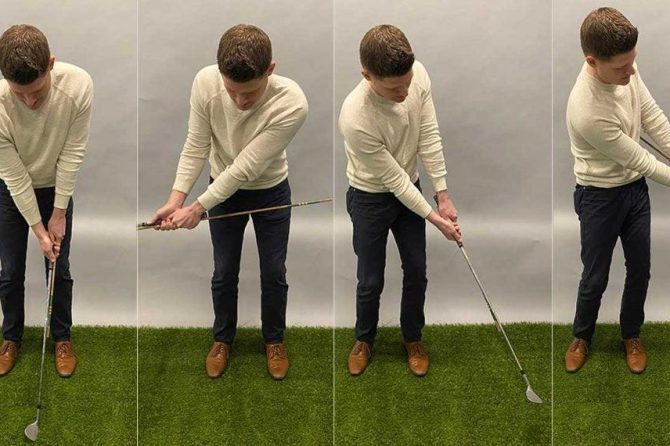In the world of golf, mastering the art of chipping is a crucial skill that hinges on a deep comprehension of its foundational components. Utilizing a club with minimal loft facilitates a precise trajectory, while positioning the ball towards the rear of the stance enhances accuracy. The key to a successful chip lies in the descending blow just before ground contact, which instigates backspin, ensuring a controlled and accurate shot with minimal elevation. These fundamental principles pave the way for chipping expertise, empowering golfers to execute shots with finesse and accuracy. By honing these core elements, golfers can adeptly navigate approach shots, thereby enhancing their overall performance on the golf course.
When it comes to optimal chipping performance, selecting the right club is paramount for achieving accuracy and control. Typically, using low-lofted wedges within the 52 to 60-degree range is recommended for chipping tasks. These clubs enable a lower trajectory, allowing the ball to travel less and stop closer to the target hole.
Considerations such as the distance to the hole, the lie of the ball, and the conditions of the green play a vital role in club selection. The loft of the club is determined by the distance to the hole, with shorter distances usually requiring a higher loft and longer distances benefiting from a lower loft. Additionally, the lie of the ball on various terrains can dictate the loft needed to generate sufficient backspin for precise ball control. The speed and firmness of the greens also impact club selection, with harder greens necessitating a lower loft to prevent excessive rolling and softer greens allowing for a higher loft to induce more backspin and quick stops.
Here is a reference table detailing the common chipping clubs and their respective loft degrees:
– Sand Wedge: 56-58 degrees
– Gap Wedge: 50-52 degrees
– Pitching Wedge: 48-50 degrees
– 9-Iron: 41-45 degrees
Accurate ball positioning is another critical aspect of successful chipping, contributing significantly to enhanced accuracy and control. Placing the golf ball towards the rear of the stance with a slight forward press ensures optimal control over the clubface angle, promoting a consistent striking technique.
The precise positioning of the ball is essential for achieving accuracy and predictability in shots, allowing golfers to control the angle of attack and ensure solid contact with the clubface. By mastering ball positioning, golfers can enhance their control over the spin and trajectory of the ball, leading to more consistent and accurate shots on the course.
Maintaining a smooth swing sequence, aligning the body correctly, and selecting the appropriate club are key techniques for optimizing precision in chipping. Proper body alignment, with feet shoulder-width apart and knees slightly bent, ensures a balanced stance for executing the chip with precision. Choosing a low-lofted wedge, such as a club with 56-60 degrees, promotes a low and rolling shot ideal for chipping scenarios. Gradually accelerating the clubhead through the swing aids in delivering the desired depth and spin on the ball, enhancing overall control and accuracy.
To refine sensitivity and consistency in chipping, a delicate touch akin to a painter’s brushstroke is essential. Golfers must exhibit a deft grip, strike a balance between firmness and lightness, position hands relaxedly, with the left hand slightly below the right (for right-handed golfers). Chipping requires a sensitive touch, emphasizing fluid motion over power, guiding the club through the impact zone for optimal results.
Ascending levels of proficiency in chipping call for drills that simulate real on-course challenges, enhancing adaptability and strategic decision-making. By practicing drills that focus on specific shot types like high lobs or low runners, golfers can sharpen their versatility and build confidence in executing diverse shots with precision.
the complexity of golf chipping necessitates a nuanced understanding of its core principles, including club selection, ball positioning, and the mechanics of the descending blow. By meticulously analyzing and mastering these fundamental elements, golfers can unlock the secrets to accurate and controlled chipping, elevating their short game and conquering the challenges of the greens with enhanced precision and confidence.

The Fundamentals of Golf Chipping: A Comprehensive Analysis
In the realm of golf, chipping emerges as a crucial element of successful greenside play. To achieve proficiency in this vital shot, a profound grasp of its core principles is indispensable. This article presents a comprehensive analysis of golf chipping, meticulously examining fundamental aspects such as club selection, ball positioning, and the calibrated descending blow. By elucidating these key concepts, golfers will acquire an in-depth understanding of the techniques that govern accurate and controlled chipping. In doing so, they will enhance their proficiency on the course, unlocking the potential for more effective and impactful performances.
Club Selection for Optimal Chipping Performance
Chipping with precision demands the right club selection to achieve accuracy and control. Choosing low-lofted wedges within the 52 to 60-degree range is recommended for chipping scenarios. These clubs facilitate a lower trajectory, allowing the ball to travel less and stop closer to the hole.
Factors to Consider:
-
Distance to the Hole: Tailoring the loft of the club based on the distance to the hole is crucial. Shorter distances typically require higher loft for precision, while longer distances benefit from lower loft clubs.
-
Lie of the Ball: The lie of the ball, whether on a flat, upslope, or downslope surface, influences club selection. Rough or uneven terrain may necessitate a steeper loft to control ball trajectory effectively.
-
Green Conditions: The speed and firmness of the greens impact club selection. Firm greens require lower loft to prevent excessive rolling, while softer greens allow for higher loft to induce backspin for quicker stops.
Table: Common Chipping Clubs and Their Loft
| Club | Loft (Degrees) |
|---|---|
| Sand Wedge | 56-58 |
| Gap Wedge | 50-52 |
| Pitching Wedge | 48-50 |
| 9-Iron | 41-45 |
Precise Ball Positioning: Enhancing Accuracy and Control
Accurate ball positioning is paramount for chipping success. Placing the golf ball towards the rear of the stance with a slight forward press ensures optimal control over the clubface angle, promoting consistency in the striking technique.
Why Precise Ball Positioning Matters:
-
Enhanced Accuracy: Correct ball positioning leads to better control over the angle of attack, resulting in solid and predictable shots.
-
Increased Control: Proper ball positioning allows for greater spin and trajectory control, enhancing shot manipulation.
-
Improved Consistency: Consistent ball positioning promotes uniformity in the chipping motion, leading to greater accuracy and precision on the course.
Tips for Precise Ball Positioning:
- Align the clubface with the target and position the ball in line with the club’s toe.
- Experiment with different ball positions to optimize accuracy and control.
- Use a reference point on the ground or clubhead for consistent positioning from shot to shot.
Calibrating the Descending Blow: Mechanics and Techniques for Success
The essential descending blow in chipping requires meticulous attention to mechanics and technique to generate backspin and control shot trajectory effectively.
Mechanics of the Descending Blow:
- Swing Plane: Maintain a shallow, descending swing arc, aiming to strike the ball from behind.
- Contact Point: Hit the ball in the center of the clubface for optimal control and consistency.
- Weight Distribution: Shift weight forward at impact to enhance downward force on the ball.
Techniques for Enhancing Precision:
- Body Alignment: Position the body in a balanced stance with feet shoulder-width apart and knees slightly bent.
- Club Selection: Opt for a low-lofted wedge to promote a low, rolling shot.
- Impact Control: Gradually accelerate the clubhead through the swing for desired depth and spin on the ball.
Fine-Tuning Your Technique:
| Element | Tips |
|---|---|
| Distance Control | Adjust swing length and velocity to vary the distance of the chip. |
| Height Control | Manipulate loft angle and impact point to elevate or lower the trajectory. |
| Spin Generation | Increase downward force or adjust clubface angle for more backspin on shots. |
Mastering the Delicate Touch: Refining Sensitivity and Consistency
Chipping demands a delicate touch akin to a painter’s brushstroke. Sensitivity and consistency play pivotal roles in imparting backspin and control for precise shots.
- Deft Grip: Maintain a light yet firm grip for stable club connection.
- Sensitive Touch: Focus on a soft and delicate swing motion for controlled shots.
- Sequencing: Ensure a smooth swing sequence with timely wrist release for backspin control.
Chipping Timing
| Lower Grip Release | Less Backspin, More Height |
|---|---|
| Delayed Grip Release | More Backspin, Less Height |
Practice and Drills: Honing Chipping Skills for Proficiency and Refinement
Establishing a solid conceptual foundation for chipping is essential. Consistent practice and targeted drills are invaluable for developing muscle memory and refining technique.
Start with fundamental chipping drills emphasizing body alignment, weight distribution, and swing tempo. These drills aid in adjusting techniques based on specific shot requirements, enhancing consistency and accuracy.
Progress to drills simulating realistic on-course scenarios to enhance adaptability and strategic decision-making. Challenges like short game challenges with obstacles prepare golfers for varied chipping scenarios, refining versatility and confidence in executing precise shots.
mastering the intricate art of golf chipping requires a deep understanding of its fundamental principles. By delving into club selection, ball positioning, and the mechanics of the descending blow, golfers can unlock the secrets to accurate and controlled chipping, ultimately enhancing their performance on the course. With practice and precision, golfers can elevate their chipping skills to new heights, ensuring success in greenside play.




